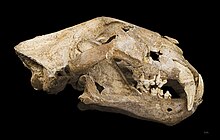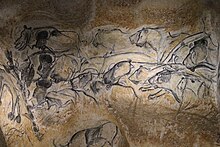穴獅
| 穴獅 | |
|---|---|

| |
| 科學分類 | |
| 界: | 動物界 Animalia |
| 門: | 脊索動物門 Chordata |
| 綱: | 哺乳綱 Mammalia |
| 目: | 食肉目 Carnivora |
| 科: | 貓科 Felidae |
| 屬: | 豹屬 Panthera |
| 種: | †穴獅 P. spelaea
|
| 二名法 | |
| †Panthera spelaea Goldfuss, 1810
| |

| |
| 穴獅分佈區域(紅色) 美洲擬獅分佈區域(藍色) 獅分佈區域(綠色) | |
| 異名 | |
|
Panthera leo spelaea | |
穴獅(英語:Panthera leo spelaea)又稱洞獅、洞穴獅,是一種已經滅絕的豹屬物種,在第三次克羅默爾間冰期於歐洲出現,少於 600,000 年前。它們與現代獅子擁有同樣的祖先,是住在洞裏的肉食性猛獸,捕食大地獺、小型的囓齒動物、及其他草食動物等。穴獅在1萬3千年前滅絕[1]。
分類[編輯]

穴獅(Panthera spelaea)本來被視為是現代獅的亞種,因此原被命名為 Panthera leo spelaea[2][3][4][5]。然而,顱骨與齒式解剖學上的差異足以將穴獅獨立為一新種[6][7]系統發生樹上的研究成果同樣也支持這項理論[8][9][10]。
演化[編輯]

穴獅在莎勒冰期晚期或艾木間冰期早期時演化自原始獅(原始獅則是出現於 700,000 年前的歐亞大陸)[5]。在波蘭發現的穴獅骨頭碎片經放射性碳定年法判定年代大約於魏奇塞冰期的早期至晚期,大約是 109,000 至 57,000 年前[12]。歐亞大陸上的穴獅大約於 14,900 至 14,100 年前絕種。白令陸橋上的穴獅則在 13,800 至 13,300 年前魏奇塞冰期結束時絕種[1]。
由化石殘骸上的線粒體DNA分析顯示美洲擬獅為穴獅的姐妹群,約由 340,000 年前被困在柯迪勒拉冰蓋南方的穴獅族群分支演化而來[9]。 下面的支序分類表示了穴獅與其他豹屬物種的關係[10]:
| |||||||||||||||||||||||||||||||||||||||||||||||||||||||||||||||||||
描述[編輯]


穴獅時在舊石器時代常以石洞壁畫、象牙雕刻、黏土塑像的形式呈現,這些遺物代表着穴獅也可能出現於舊石器時代的宗教儀式當中[13][14]。在法國肖維岩洞(約 30,000 年前)描繪了一對走在一起的穴獅,其中一隻的體型略小於另一隻,而體型較大的個體則繪有陰囊,但不具有鬃毛[15]。這代表穴獅和現代獅子不一樣,牠們可能不具有明顯的鬃毛[1]。
在被獨立為一種時,穴獅曾是獅子所有亞種中體格最大的之一,1985 年在德國錫格斯多夫附近發現的一隻成年雄性洞穴獅化石表明,其及肩身高約1.2米(3.9英尺),身長2.1米(6.9英尺)(不含尾巴),這大致相當於一頭體型相當大的現代獅子。實際上,這只洞穴獅並不是同類中最大的,因此可以推斷,洞穴獅要比現代獅子大5%到10%,但比較早期的原始獅(Panthera fossilis)還有之後的美洲擬獅小[16]。和現代獅子一樣,雌獅的體型較雄獅小[17]
古生態學[編輯]
穴獅生活在一些開闊的環境如猛獁草原或是北方針葉林。牠們的骨骼多半與洞鬣狗、洞熊和舊石器時代文物一同在洞穴中發現因而得名[18][19]。穴獅可能為獨居性的掠食者[20]。
從化石中膠原蛋白樣本的同位素分析顯示穴獅主要以洞熊幼崽、馴鹿與其他鹿科為主食,尤其是馴鹿[21]。其他可能的獵物包括大角鹿、歐洲馬鹿、麝牛、西伯利亞野牛、幼年披毛犀以及幼年猛獁象[1]。
參見[編輯]
參考來源[編輯]
- ^ 1.0 1.1 1.2 1.3 Stuart, A. J., Lister, A. M. Extinction chronology of the cave lion Panthera spelaea. Quaternary Science Reviews. 2011, 30 (17): 2329–2340. doi:10.1016/j.quascirev.2010.04.023.
- ^ Kurtén, B., 1968. Pleistocene Mammals of Europe. Weidenfeld and Nicolson, London.
- ^ Hemmer, H. Untersuchungen zur Stammesgeschichte der Pantherkatzen (Pantherinae) Teil 3. Zur Artgeschichte des Löwen Panthera (Panthera) leo (Linnaeus, 1758). Veröffentlichungen der Zoologischen Staatssammlung 17. 1974: 167–280.
- ^ Turner, A. Dental sex dimorphism in European lions (Panthera leo L.) of the Upper Pleistocene: palaeoecological and palaeoethological implications. Annales Zoologici Fennici. 1984, 21: 1–8.
- ^ 5.0 5.1 Burger, J.; Rosendahl, W.; Loreille, O.; Hemmer, H.; Eriksson, T.; Götherström, A.; Hiller, J.; Collins, M. J.; Wess, T.; Alt, K. W. Molecular phylogeny of the extinct cave lion Panthera leo spelaea. Molecular Phylogenetics and Evolution. 2004, 30 (3): 841–849 [2011-12-17]. PMID 15012963. doi:10.1016/j.ympev.2003.07.020. (原始內容存檔於2019-06-26).
- ^ Spassov, N., Iliev, N. Animal remains from the submerged Late Eneolithic – early Bronze Age settlements in Sozopol (South Bulgarian Black Sea Coast). Proceedings of the International Symposium VI. Thracia Pontica. 1994: 287–314.
- ^ Sotnikova, M., Nikolskiy, P. Systematic position of the cave lion Panthera spelaea (Goldfuss) based on cranial and dental characters. Quaternary International. 2006,. 142-143: 218–228. doi:10.1016/j.quaint.2005.03.019.
- ^ Christiansen, P. Phylogeny of the great cats (Felidae: Pantherinae), and the influence of fossil taxa and missing characters. Cladistics. 2008, 24 (6): 977–992. doi:10.1111/j.1096-0031.2008.00226.x.
- ^ 9.0 9.1 Barnett, R., Shapiro, B., Barnes, I. A. N., Ho, S. Y., Burger, J., Yamaguchi, N., Higham, T. F., Wheeler, H., Rosendahl, W., Sher, A. V., Sotnikova, M. Phylogeography of lions (Panthera leo ssp.) reveals three distinct taxa and a late Pleistocene reduction in genetic diversity (PDF). Molecular Ecology. 2009, 18 (8): 1668–1677. PMID 19302360. doi:10.1111/j.1365-294X.2009.04134.x. (原始內容 (PDF)存檔於21 January 2012).
- ^ 10.0 10.1 Barnett, R.; Mendoza, M. L. Z.; Soares, A. E. R.; Ho, S. Y. W.; Zazula, G.; Yamaguchi, N.; Shapiro, B.; Kirillova, I. V.; Larson, G.; Gilbert, M. T. P. Mitogenomics of the Extinct Cave Lion, Panthera spelaea (Goldfuss, 1810), Resolve its Position within the Panthera Cats. Open Quaternary. 2016, 2: 4. doi:10.5334/oq.24.
- ^ Chauvet, J.-M.; Brunel, D. E.; Hillaire, C. Dawn of Art: The Chauvet Cave. The oldest known paintings in the world. New York: Harry N. Abrams. 1996.
- ^ Marciszak, A., and Stefaniak, K. Two forms of cave lion: Middle Pleistocene Panthera spelaea fossilis Reichenau, 1906 and Upper Pleistocene Panthera spelaea spelaea Goldfuss, 1810 from the Bisnik Cave, Poland. Neues Jahrbuch für Geologie und Paläontologie, Abhandlungen. 2010, 258 (3): 339–351. doi:10.1127/0077-7749/2010/0117.
- ^ Bahn, P. G., Vertut, J. Journey Through the Ice Age. London: Weidenfeld & Nicolson. 1997.
- ^ Guthrie, R. D. The Nature of Paleolithic Art. Chicago: University of Chicago Press. 2005.
- ^ Yamaguchi, N.; Cooper, A.; Werdelin, L.; MacDonald, D. W. Evolution of the mane and group-living in the lion (Panthera leo): a review. Journal of Zoology. 2004, 263 (4): 329–342. doi:10.1017/S0952836904005242.
- ^ Koenigswald, W. v. (2002). Lebendige Eiszeit. Darmstadt: Theiss-Wissenschaftliche Buchgemeinschaft. ISBN 3-8062-1734-3
- ^ Diedrich, C. G. Late Pleistocene Panthera leo spelaea (Goldfuss, 1810) skeletons from the Czech Republic (central Europe); their pathological cranial features and injuries resulting from intraspecific fights, conflicts with hyenas, and attacks on cave bears. Bulletin of Geosciences. 2011, 86 (4): 817–840. doi:10.3140/bull.geosci.1263.
- ^ Diedrich, C. G. The largest European lion Panthera leo spelaea (Goldfuss 1810) population from the Zoolithen Cave, Germany: specialised cave bear predators of Europe. Historical Biology. 2011, 23 (2–3): 271–311. doi:10.1080/08912963.2010.546529.
- ^ Diedrich, C. G. Pleistocene Panthera leo spelaea (Goldfuss 1810) remains from the Balve cave (NW Germany) - a cave bear, hyena den and middle palaeolithic human cave – and review of the Sauerland Karst lion cave sites. Quaternaire. 2011, 22 (2): 105–127.
- ^ Bocherens, H. Isotopic tracking of large carnivore palaeoecology in the mammoth steppe. Quaternary Science Reviews. 2015, 117: 42–71. doi:10.1016/j.quascirev.2015.03.018.
- ^ Bocherens, H., Drucker, D. G., Bonjean, D., Bridault, A., Conard, N. J., Cupillard, C., Germonpré, M., Höneisen, M., Münzel, S. C., Napierala, H., and Patou-Mathis, M. Isotopic evidence for dietary ecology of cave lion (Panthera spelaea) in North-Western Europe: prey choice, competition and implications for extinction (PDF). Quaternary International. 2011, 245 (2): 249–261. doi:10.1016/j.quaint.2011.02.023.[永久失效連結]
外部連結[編輯]
| 維基物種上的相關資訊:穴獅 |
| ||||||||||||||||||||||||||||||||||||||||||||||||||||||||||||||||||||||||||||||||||||||||||||||||||||||||||||||||||||||||||||||||||||||||||||||||||||||||||||||||||||||||
|





